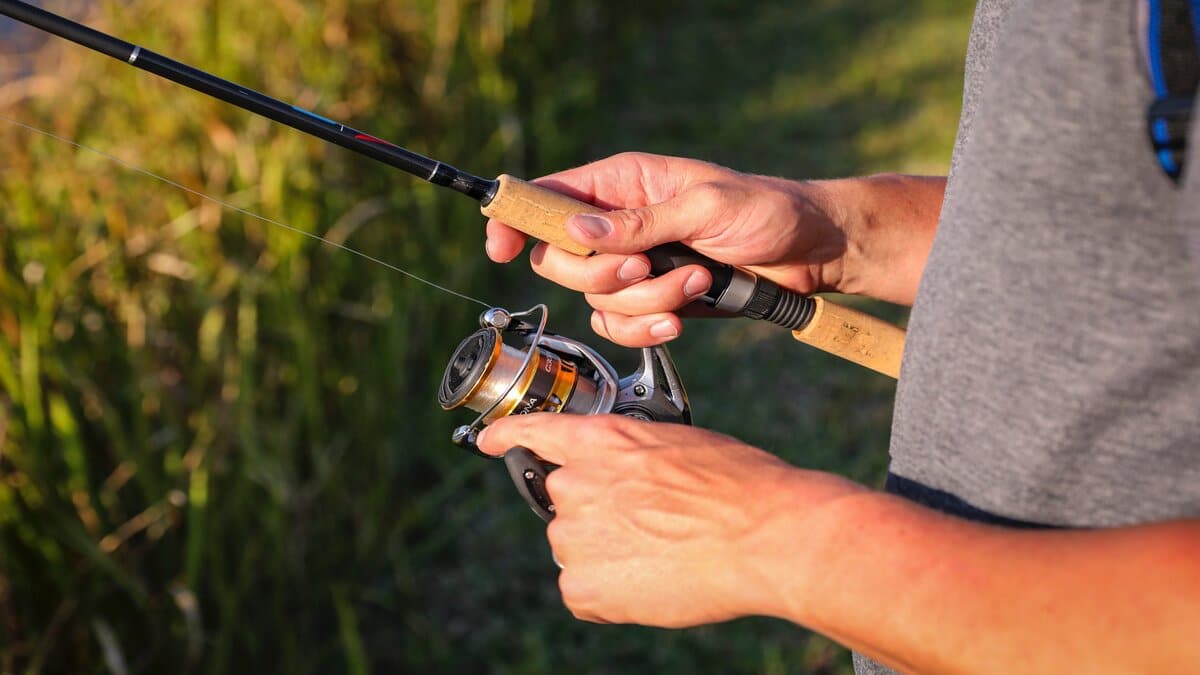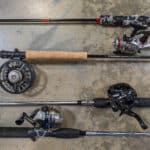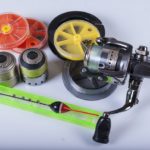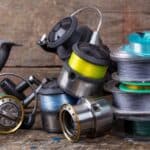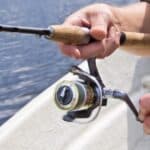Every bit of fishing gear has an effect on what you can catch and how easy it’s going to be to reel it in. Fishing reels rank among the most crucial equipment that you’ll buy when starting out or adding to your current quiver.
Once you start looking into a new fishing reel, there are plenty of decisions that you need to make. One of the first things you’ll notice is the wide range of different fishing reel sizes out there.
The ideal fishing reel size greatly relies on the type of fishing you do and the species you aim to catch. Generally, larger reel sizes handle bigger fish and offer easier operation. A 2000-3000 spinning reel serves as a versatile size for freshwater fishing starters.
But there’s a lot more to it than just grabbing the most expensive reel and heading out. Here are all of the different fishing reel sizes explained.
DISCLOSURE: As an Amazon Associate I earn from qualifying purchases. Many links in this article are affiliate links. If you click on a link we may earn a commission if you make a purchase, at no additional cost to you.
How Do I Choose the Right Size Fishing Reel?
Choosing the right size fishing reel comes down to knowing exactly what you want to catch, the type of fishing you’re going to be doing, and the other details of the gear you already have.
Before starting there, it’s important to understand the numbers that you’re looking at because they often don’t match up between different brands.
Shimano, Daiwa, and Penn will use numbers in the thousands, ranging from 1000 (the smallest) all the way to 30,000 in their larger game reels. Most of the reels you’re likely to look at from them will range between 1000 and 6000.
Abu Garcia and Pfleuger only use the first two digits of those larger numbers. For example, a 1000 Shimano reel will be the same size as an Abu Garcia 10.
For all of the charts in this article, we’ll refer to Shimano’s numerical system that can be easily translated down to Abu Garcia or Pfleuger.
We can break down fishing reel sizes into three general categories; small (1000-3500), medium (4000-5500), and large (6000 and up). Each of these categories will be split up further, but this can help you pair your reel size with other pieces of gear such as your fishing rod.
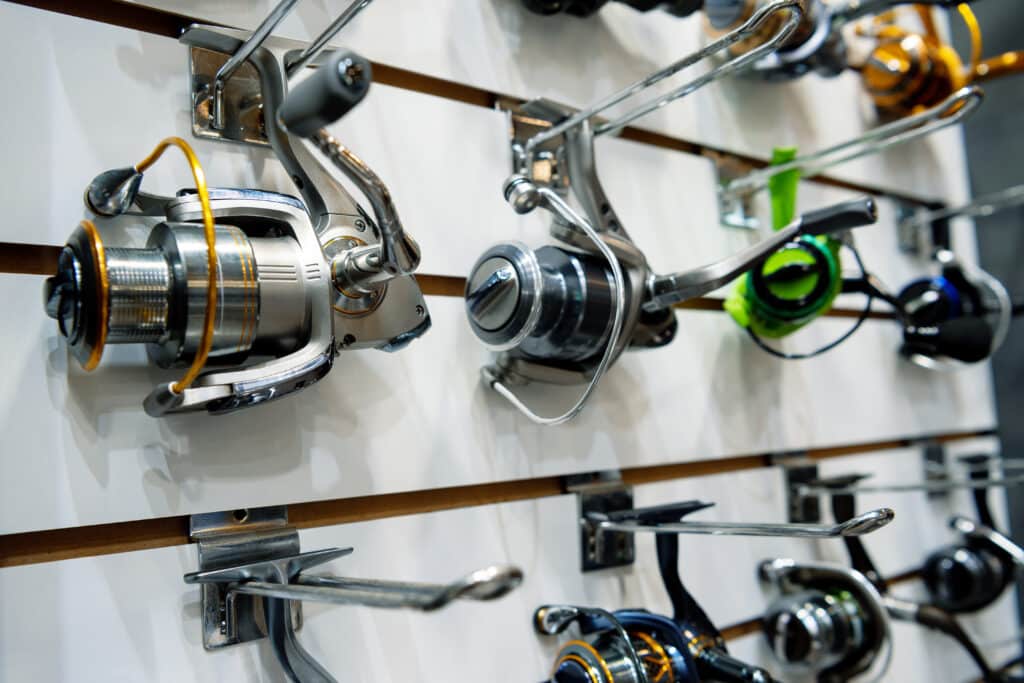
What Size Reel for My Rod?
Because we’re looking at fishing reel sizes and the different sizes of fish that each can catch, it’s necessary to also talk about the size of your fishing rod. This has a major influence over the fish you can catch, so it must be paired correctly with the right size reel.
Lightweight rods between 6 and 7 feet will be paired with a small-sized reel to match. Medium rods between 7 to 8 feet will pair with the medium-sized reels, and anything larger will go with a large reel.
Pairing rod and reel makes a lot of sense when you think about what you’re fishing for. Smaller rods are used for smaller fish like crappie, bluegill, trout, and other panfish. So you need a smaller reel that also is fit for smaller fish. The same goes for trying to snag larger freshwater fish with a medium-sized rod or giant sea-dwellers with a surf caster.
If you’re just starting out, you’ll find tons of information about buying a rod and reel, but which should you buy first? Both the rod and reel can be bought at the same time to make sure you pair them well for the type of fishing you’re hoping to do.
| Spinning Reel Size | Rod Size | Line Rating |
| 1000 | 6-7 feet | 2-8 pounds |
| 2000-2500 | 6-7 feet | 4-10 pounds |
| 3000-3500 | 6-7.5 feet | 6-15 pounds |
| 4000-5000 | 6-8 feet or 8-10 foot light rod | 8-22 pounds |
| 5500 | 6-8 feet or 10-11 foot medium rod | 10-22 pounds |
| 6000 | 8-9 feet or 10 foot surf rod | 15-35 pounds |
| 7000 | 8-9 feet or 10-12 foot beach rod | 15-45 pounds |
| 8000 | 12 feet and up | 25-50 pounds |
| 10,000 | 12 feet and up | Above 25 pounds |
What Size Fishing Reel for First Time Fishing?
For your first time out fishing you’re most likely to be fishing for smaller panfish, which is perfect since the smaller the reel, the easier it is to use. I started out fishing with a 6-foot rod and a 1000 reel. It felt like the best option for me since I was young, inexperienced, and needed something that made it all feel a bit easier.
First-time anglers will benefit greatly from using a small-sized reel paired with a smaller rod so they can best practice technique before needing to handle and manage a larger size.
Does Fishing Reel Size Matter?
Fishing reel size can make all the difference when you’re trying to bring something in. A larger reel is built to take on heavier line, necessary for a larger fish. If you tried using a smaller reel, the possibility of the reel spinning out and you losing your catch is much higher.
I’ve tried using smaller reels when some trophy fish have shown up because it was all I had at the time, but ended up disappointed with a broken line and nothing to show for it.
The size of a fishing reel also has other effects on your fishing performance. The diameter of the fishing reel changes how far you can cast out. A larger reel will let out more line with every rotation, allowing for a further cast.
The same goes for when you’re reeling a fish in. The larger reels will bring in more line at once, which makes them better equipped for fighting larger fish. Larger reels become a problem when you are wanting more finesse, which a smaller reel provides.
Spinning Reel Size Chart
| Size | Application | Mono Line Weight | Braided Line Weight | Fish Species |
| Small Reel Sizes | ||||
| 1000-2000 | Ultralight fishing in fresh and calm water | 2-4 pounds | 4-8 pounds | Trout, Crappie, Bluegill, Yellow Perch |
| 2000-2500 | Light spin fishing in fresh and calm water | 4-8 pounds | 5-12 pounds | Bass, Trout, Walleye, Northern Pike, Mackerel |
| 3000-3500 | Light spin fishing in fresh and calm water | 6-10 pounds | 6-14 pounds | Bass, Walleye, Catfish, Northern Pike, Mackerel |
| Medium Reel Sizes | ||||
| 4000-4500 | Medium duty fishing | 8-12 pounds | 8-20 pounds | Catfish, Muskie, Redfish, Snapper, Snook |
| 5000-5500 | Medium duty fishing in fresh and inshore saltwater | 10-14 pounds | 10-25 pounds | Catfish, Muskie, Redfish, Snapper, Snook, Carp |
| Large Reel Sizes | ||||
| 6000-7000 | Medium duty fishing in inshore and offshore saltwater | 12-16 pounds | 12-30 pounds | Striped bass, Salmon, Snook, Redfish, Carp, Cod, Grouper |
| 8000-10000 | Heavy fishing in offshore saltwater | 16-25 pounds | 20-50 pounds | Wahoo, Roosterfish, Dorado, Barracuda, Amberjack, Cod, Grouper, Tarpon |
| 10000 and up | Deep sea fishing | 25+ pounds | 50-100 pounds | Tuna, Wahoo, Dorado, Shark, Tarpon, Sailfish |
Small Reels
Reels ranging from 1000 to 3500 are best suited for ultralight and light freshwater spin fishing with lighter line weights. If you’re after panfish like small trout, crappie, or mackerel, this is the reel size for you.
Medium Reels
Reels landing in the middle, between 4000 and 6000, will perform well when paired with mid-range rods and used in medium-duty fishing applications either in freshwater or inshore saltwater.
Large Reels
Finally, the largest reels are designed to reel in larger fish with larger rods built to haul in offshore beasts and deep sea fish. These reels start as low as 8000 but can get all the way up to a 30,000 size.
How To Pick Spinning Reel Size
If you’re a fan of spinners, you’ll want to be paying attention to all the different sizes available and especially what works best for certain applications.
One of the more common frustrations that you’ll run into is the inconsistency between the popular brands. A general rule of thumb is to only pay attention to the first two numbers in the size, and know that as the number increases, so does the size.
To pick the right spinning reel size, know what you’re trying to fish for and how you’re going to do it. This is going to have the greatest influence over what you’re going to end up with, but you also need to know your rod size.
Once you’ve figured this out, all you need to do is jump up to the size chart and find which size fits your application. Within the ranges provided, you can match a reel to your rod and application for the best possible results.
How To Choose Saltwater Spinning Reel Size?
Right off the bat, saltwater spinning reels tend to be larger than others. While you can get away with a medium-sized reel for some inshore fishing, you might be after some of the offshore beasts.
In this case, you only need to look at the large-sized reels. These are going to be capable of casting out far enough and bringing in any of the behemoths that you hopefully snag while out there.
It’s important to not get too in over your head. Grabbing a 30,000-size reel when trying to catch salmon will be extreme overkill, and likely will make your life a bit harder. Narrow it down and be realistic with what you’re hoping to catch and what’s available in your area.
Best Size Spinning Reel for Bass
The best spinning reel for bass will range anywhere between 2000 and 3500. This can reflect the size of bass you’re planning on catching, as well as where you’re fishing for them. Additionally, if you want this reel to be for more than one purpose, you may look on either end if you’re hoping to catch more panfish, or alternatively, more larger fish.
Spinning Reel Size for Catfish
A medium-sized reel (4000-5500) paired with a seven or eight-foot rod is going to be the best combination for fishing catfish. You get the versatility and power of a medium-sized reel, with the fighting power of a slightly longer rod.
For example, this spinning reel and rod setup features a size 50 reel with a 7’ rod, which is just about perfect for most catfishing.
How To Pick Baitcaster Reel Size
Baitcasters are measured slightly differently than spinners, meaning you need to nail down a completely different set of numbers for this fishing class. Fortunately, the same concept is in place; as the number goes up, the reel gets larger. Larger reels are still meant for larger fish and more heavy-duty applications.
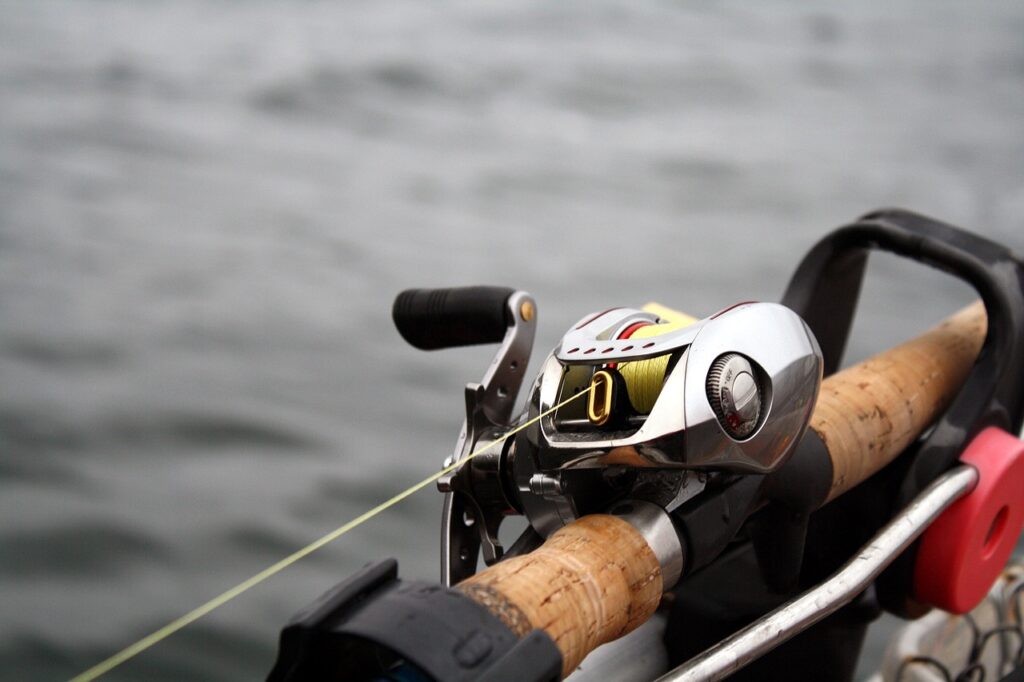
For baitcasters, the different sizes can vary between different brands. A 100 may be the same as a 300, depending on who you’ve bought it from. Some manufacturers (Abu Garcia) don’t even use size on their baitcasters, so you need to gauge the best from the line capacity rating. Regardless, the numbers are there just to help you get a good idea of what reel to buy for your certain use.
Line capacity, the largest amount of line the reel can hold before overloading, will be one of the most important things to look at when choosing the right baitcasting reel size. You may also pay attention to the retrieve rate and maximum drag, which can greatly influence the size of fish you’re able to bring in with ease.
There’s a massive crossover in baitcaster reel sizes, just like with spinners, so you’ll find that many anglers have differing opinions on what is best. It comes down to personal preference, but a general understanding can be helpful to start off with a reel size in the right neighborhood.
Baitcasting Reel Size Chart
| Size | Line Capacity (lb/yd) | Retrieve Rate (ipt) | Max Drag | Application |
| 50 | 12/65 | 23”-29” | 10 lb | Ultralight trout and bass |
| 70 | 12/85 | 23”-32” | 10 lb | Finesse bass fishing |
| 100 | 12/120 | 26”-34” | 11 lb | All-around bass |
| 200 | 12/200 | 26”-36” | 12 lb | Heavy bass |
| 300 | 12/260 | 26”-36” | 22 lb | Inshore saltwater |
| 400 | 12/330 | 26”-38” | 25 lb | Inshore saltwater |
How To Pick Spincasting Reel Size
Spincasters, while similar to spinning reels, are capable of handling much larger bait than their close relatives, are easier to use for beginners, and much less precise and capable when it comes to casting a further distance.
From the nature of these two reels, you can tell that spincasting reels will tend to be a bit larger as they are more equipped for larger bait and less precise finesse fishing. This tends to be for those out on larger open water where larger fish hang out.
The sizing of spincast reels is the same as spinners, so it’s as easy as checking out the size of the reel you’re interested in and comparing it to the chart above.
How To Pick Fly Reel Size
Fly reel sizes are traditionally measured in weight, rather than an actual measurement of their physical size. The thicker the line you are using, the wider the diameter of your reel needs to be. This makes picking the right reel size both easier and more complicated for anyone that’s new to the game.

In general, picking the right fly reel size will start like picking any other reel, by knowing what you’re hoping to catch and how you’ll use the rod. This will tell you your desired line capacity, and line weight, which will lead you toward the right reel size.
Always take your rod down to the shop and try out different fly reels. The right one for you will be in the middle between too light and too heavy, will add a solid balance to the rod, and will be capable of holding a strong enough line to catch whatever you’re hoping to snag.
Fly Fishing Reel Size Chart
| Fly Reel Size | Application |
| 1-3 wt | Panfish and small bass |
| 3-4 wt | Small trout, bass, bream |
| 5 wt | All around for trout |
| 6-7 wt | Big bass, big trout |
| 8-9 wt | Sea trout, big bass, redfish, pike |
| 10-12 wt | Tarpon |
What Size Fishing Reel is Best?
Best Spinning Reel Size
There’s no true one-size-fits-all spinning reel size. The best spinning reel size depends on what you’re going to use it for.
The best for panfish is a small-sized reel (1000-3000). For catfish and other medium-duty fishing, use a medium-sized reel (4000-5000). Large fish and most saltwater fishing will require a large-sized reel (6000+) to help bring in any of the massive deep sea monsters that are out there.
Best Baitcaster Reel Size
Most people using a baitcasting rod are likely to be after trout or bass. The best baitcaster reel size for bass is between 70 and 100, depending on if you’re hoping to do some finesse fishing or not.
Best Spincasting Reel Size
Spincasting reels are just like spinners when it comes to size. The size depends on the application. As mentioned before, spincasting is best for large and open water, since there’s no precise casting going on, so the best spincasting reel size is most likely to be on the medium to large end.
Best Fly Reel Size
I’ve always found that a 5-weight fly reel has me covered for most of the fly fishing that I do. That being said, I don’t ever fly fish saltwater, when I could benefit from a larger reel. I also learned with a slightly lighter line and smaller reel, but have found that the 5 wt is best all around.
Fishing Reel Size FAQs
What size spinning reel for a medium light rod?
A medium light rod will pair well with one of the “larger” small-sized reels, such as a 3000 or 3500.
What size braided line to use with a Shimano 4000 spinning reel?
A Shimano 4000 spinning reel can be used easily with anything between 8 and 20-pound braided line.
What size reel for inshore fishing?
Inshore fishing brings you to the upper end of medium-sized reels and the lower end of large-sized reels. For inshore fishing, try a reel size between 5000 and 7000.
How big is an Abu Garcia black max spinning reel size 30?
Abu Garcia uses two digits for their sizing charts, as opposed to the four used by brands like Shimano, Daiwa, and Penn. An Abu Garcia size 30 is the same as a Shimano 3000, a reel on the upper end of the smaller reel sizes.

